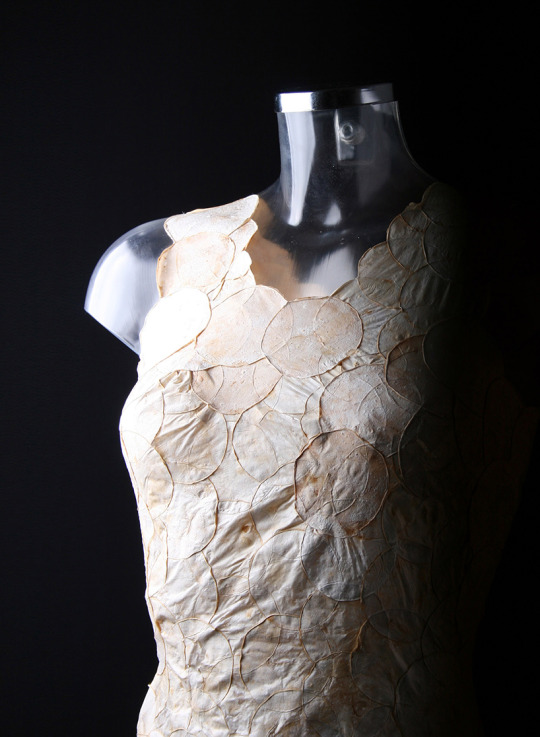Text
Fungi: fabric of sustainable fashion


(Image caption: Left: MycoTEX (a type of mushroom fabric) dress credit: Aniela Hoitink. Right: nat-2™ x Zvnder vegan sneaker line made from real fungus | Fomes fomentarius! credit: www.nat-2.eu)
Fungi are sprouting everywhere- from fashion runways to personal clothing wardrobes!
No, this is not the first time that we are spinning something out of these moisture loving small organisms. A new study confirms that native Americans were already producing “mycotextiles” at least a century ago. But it is recently that certain types of fungi taking the world of fashion by storm.
You still might unheard of that fungi can now be fashioned into clothing, purses, pants and even sneakers but this new reality is taking the fashion world in its grip.
Last year, a number of major fashion brands — Lululemon, Adidas, Stella McCartney and Gucci’s parent company — teamed up to invest “seven-figure sums” to create clothes and shoes made out of mycelium fabric with Bolt Threads, a US based biotechnology company. In fact, the mushroom market is speculated to reach a valuation of over $50 billion by 2025, according to Grand View Research.
What is leading this newly heightened appreciation for this thalloid organism?
Fashion industry has got a bad fame for very high water usage, pollution and a high carbon footprint. It is actually the world’s second-most polluting business, behind oil, as stated by the United Nations and hence, is witnessing criticisms from all corners- one such being disruption of London Fashion Week by Extinction Rebellion. Given this, right now a sustainable wave is sweeping across the fashion arena and there is more than ever pursuit for an eco-friendly means of production.
Among other innovative solutions, development of biotextiles is one because textiles have a big carbon footprint and clog landfills when discarded. In this quest, mushroom based fabrics are emerging as an exciting, aesthetically viable material alternative.
Jamie Bainbridge, product developer at bolt threads sums this up in an interview to forbes "I’ve spent a career developing materials and I’ve never seen a material with this much pull, I’ve never seen anything like this (mushroom fabrics).
What makes mushroom fabrics to stand out?
Fungi are naturally abundant in the nature and grows swiftly (on a range of waste materials like tree mulch and vegetable wastes). Different types of fabrics have been created from fungus by using different material combinations. Mycelium, lattice-like root structure of fungus, has found its many admirers in the luxury industry. Mycelium can be easily grown on a petri dish in a lab and their growth uses a lot less water than traditional textile manufacture, moreover, with no requirement of chemical fertilizers. The materials are actually made to order and there’s absolute transparency into what is being made and how. Even, we can tailor mycelium materials’ properties, for example, size, strength, flexibility, thickness and can make them hard as enamel or as soft and porous as a sponge, by altering the amount of light, humidity, exchange of gas, temperature, and types of “food” the fungi is given, this renders them as the ideal creative material for whatever you desire forging and also, being it carbon-negative, it can be naturally dyed to any colour. This customisation creates a range of design possibilities and guarantees consistent quality. There is no need for cutting, sewing, knitting etc. so, less waste is generated in the process.
Additionally, mushroom fabrics are non-toxic, fire-resistant and naturally anti-microbial (unlike other textiles, which are only made to be anti-microbial through an expensive process). In contrast to a lot of textiles, the insulating and hygroscopic properties of mycelium are very good. Most importantly, the fabric is 100 per cent biodegradable. Consequently, once a mushroom garment has reached the end of its life, it provides nutrients to the soil for other plants, forming a perfect ecological cycle.
How the future of fungi looks like?
There are still lot of uncertainties and questions about the logistics of wearing and producing mycelium. Fungal biofabrication is a labor intensive and time consuming process. For instance, it typically takes anywhere between eight to ten days to grow material for a dress. This poses challenges for production on the commercial scales. To add on this, supply chains don’t seem to be ready to handle an influx of mycelium production yet. These factors come together to add on the logistics cost of the product hence, often, rendering them prohibitively expensive for many consumers.
As mushroom based clothing and other accessories are still a new material, plausibly, it takes a while to earn reputation, acceptance, and having significant presence in retails.
Take-home message: In these times of deep climate crisis, we need to strengthen our bonding with nature and in this, mushroom can make a catwalk to a more greener future.
#sustainable fashion#Future of fashion#climate crisis#fungi#Biofabrication#Fabrics#world of fashion#mycology#radical culture#catwalk#ecofriendly#science of fashion
10 notes
·
View notes